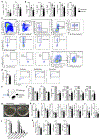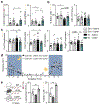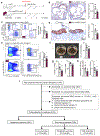Exercise reduces inflammatory cell production and cardiovascular inflammation via instruction of hematopoietic progenitor cells
- PMID: 31700184
- PMCID: PMC6858591
- DOI: 10.1038/s41591-019-0633-x
Exercise reduces inflammatory cell production and cardiovascular inflammation via instruction of hematopoietic progenitor cells
Abstract
A sedentary lifestyle, chronic inflammation and leukocytosis increase atherosclerosis; however, it remains unclear whether regular physical activity influences leukocyte production. Here we show that voluntary running decreases hematopoietic activity in mice. Exercise protects mice and humans with atherosclerosis from chronic leukocytosis but does not compromise emergency hematopoiesis in mice. Mechanistically, exercise diminishes leptin production in adipose tissue, augmenting quiescence-promoting hematopoietic niche factors in leptin-receptor-positive stromal bone marrow cells. Induced deletion of the leptin receptor in Prrx1-creERT2; Leprfl/fl mice reveals that leptin's effect on bone marrow niche cells regulates hematopoietic stem and progenitor cell (HSPC) proliferation and leukocyte production, as well as cardiovascular inflammation and outcomes. Whereas running wheel withdrawal quickly reverses leptin levels, the impact of exercise on leukocyte production and on the HSPC epigenome and transcriptome persists for several weeks. Together, these data show that physical activity alters HSPCs via modulation of their niche, reducing hematopoietic output of inflammatory leukocytes.
Conflict of interest statement
Competing interests
Authors declare no competing interests.
Figures
















Comment in
-
Exercise protects against cardiovascular disease by modulating immune cell supply.Nat Rev Cardiol. 2020 Jan;17(1):5. doi: 10.1038/s41569-019-0311-1. Nat Rev Cardiol. 2020. PMID: 31748714 No abstract available.
-
Exercise lowers leptin and leukocytosis.Nat Rev Immunol. 2020 Jan;20(1):2-3. doi: 10.1038/s41577-019-0253-1. Nat Rev Immunol. 2020. PMID: 31776481 No abstract available.
References
-
- Ridker PM Residual inflammatory risk: addressing the obverse side of the atherosclerosis prevention coin. Eur Heart J 37, 1720–1722 (2016). - PubMed
-
- Ridker PM et al. Antiinflammatory Therapy with Canakinumab for Atherosclerotic Disease. N Engl J Med 377, 1119–1131 (2017). - PubMed
-
- Madjid M, Awan I, Willerson JT & Casscells SW Leukocyte count and coronary heart disease: implications for risk assessment. J Am Coll Cardiol 44, 1945–1956 (2004). - PubMed
Publication types
MeSH terms
Substances
Grants and funding
LinkOut - more resources
Full Text Sources
Other Literature Sources
Medical
Molecular Biology Databases
Miscellaneous

